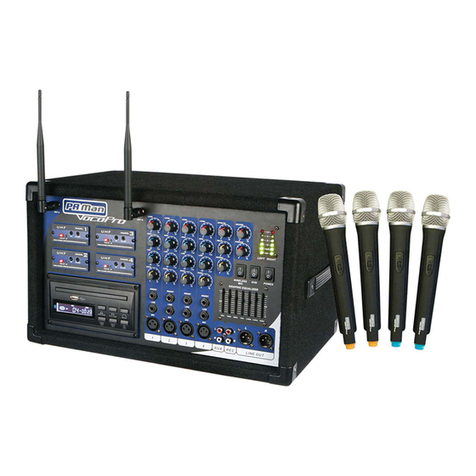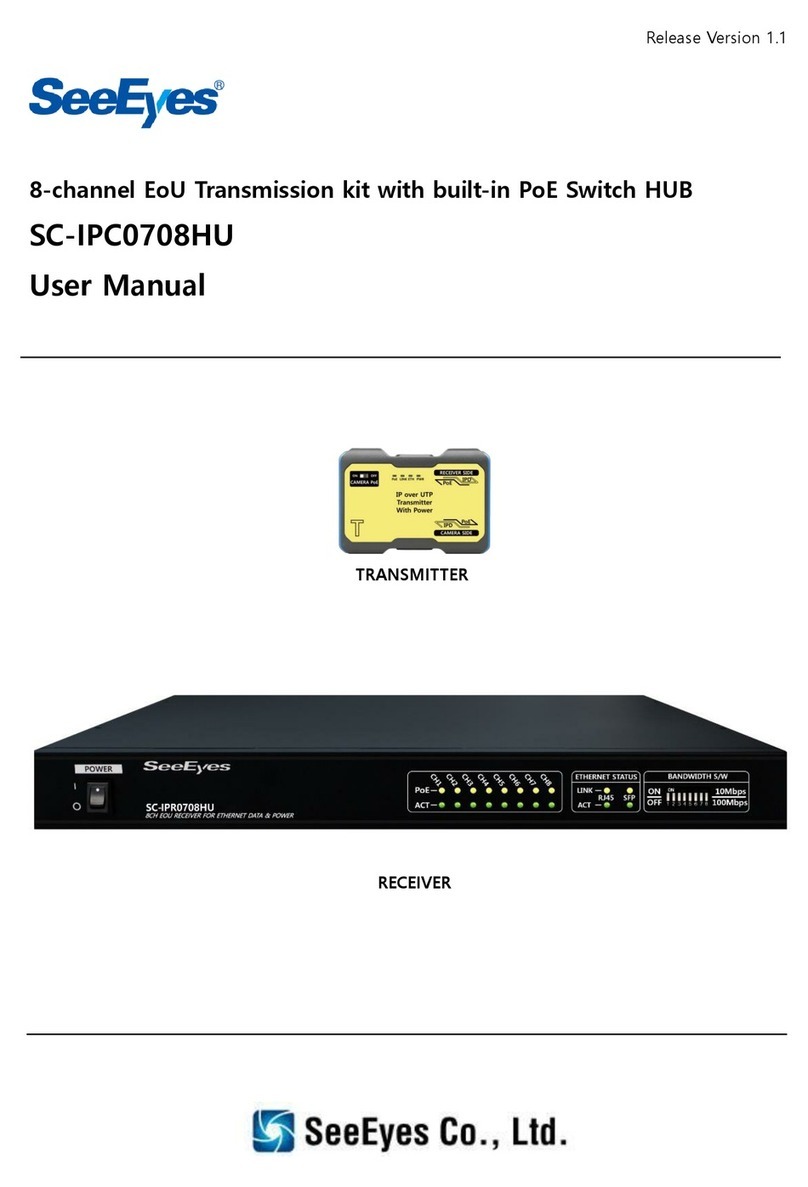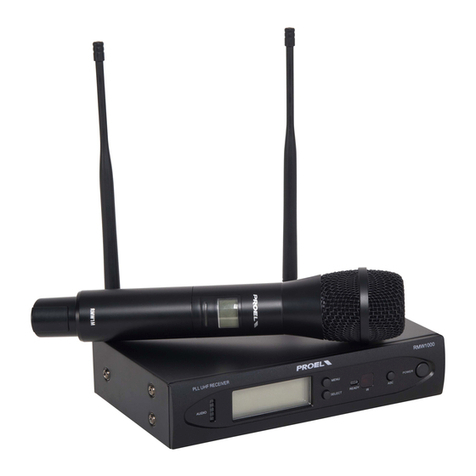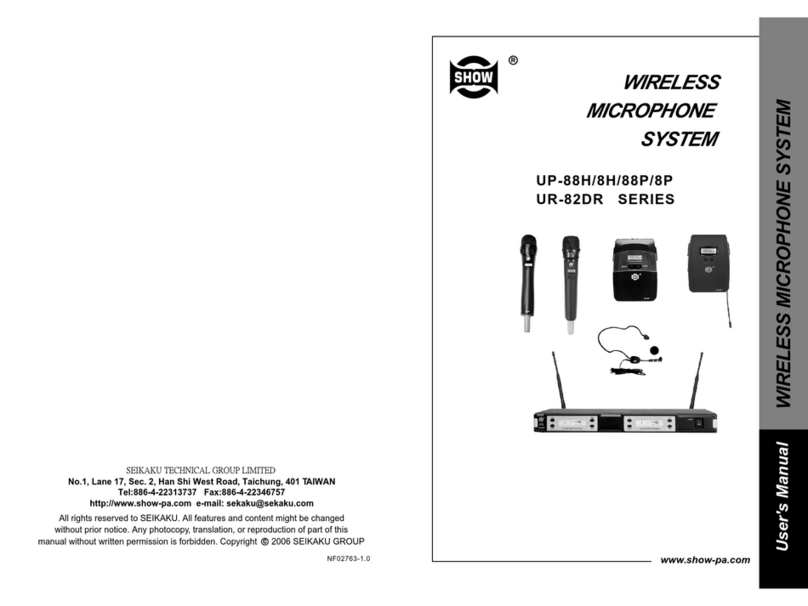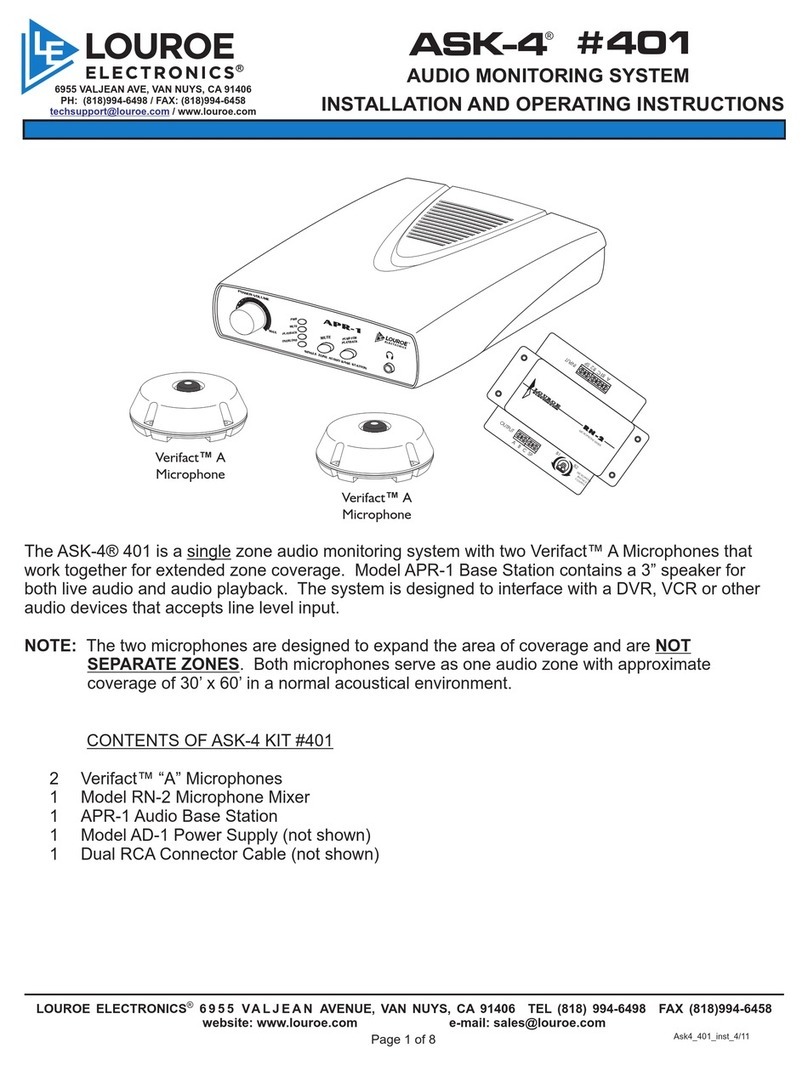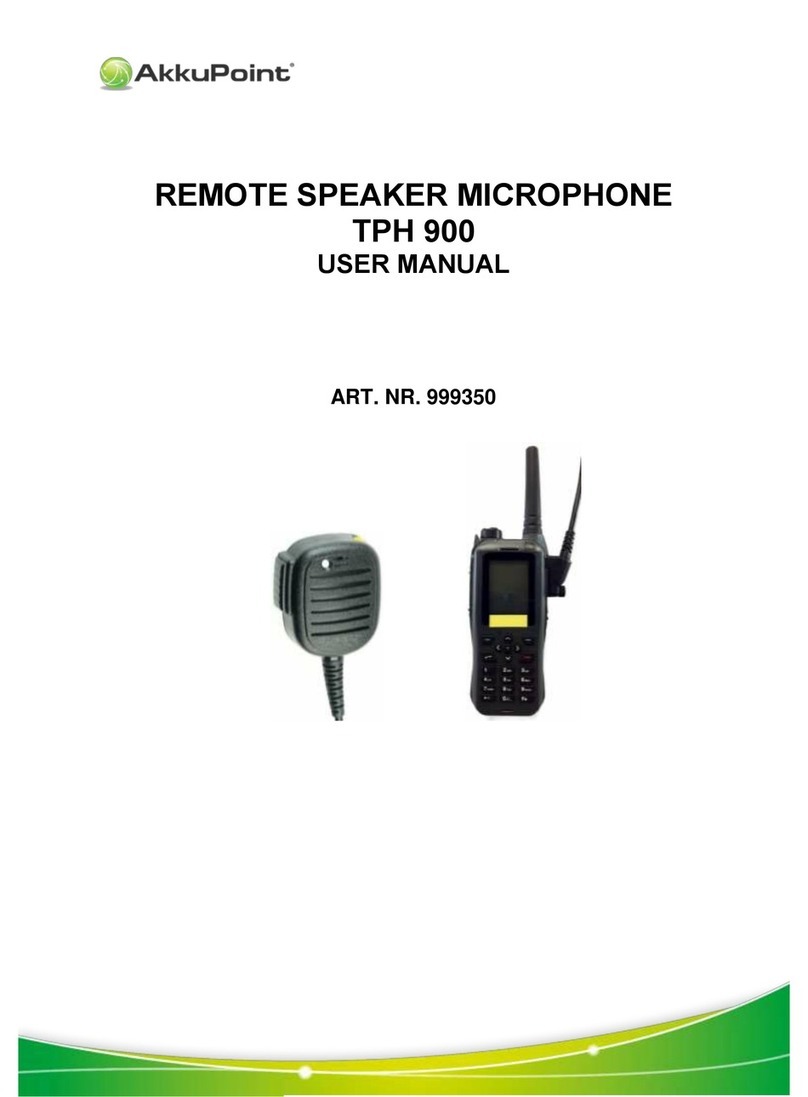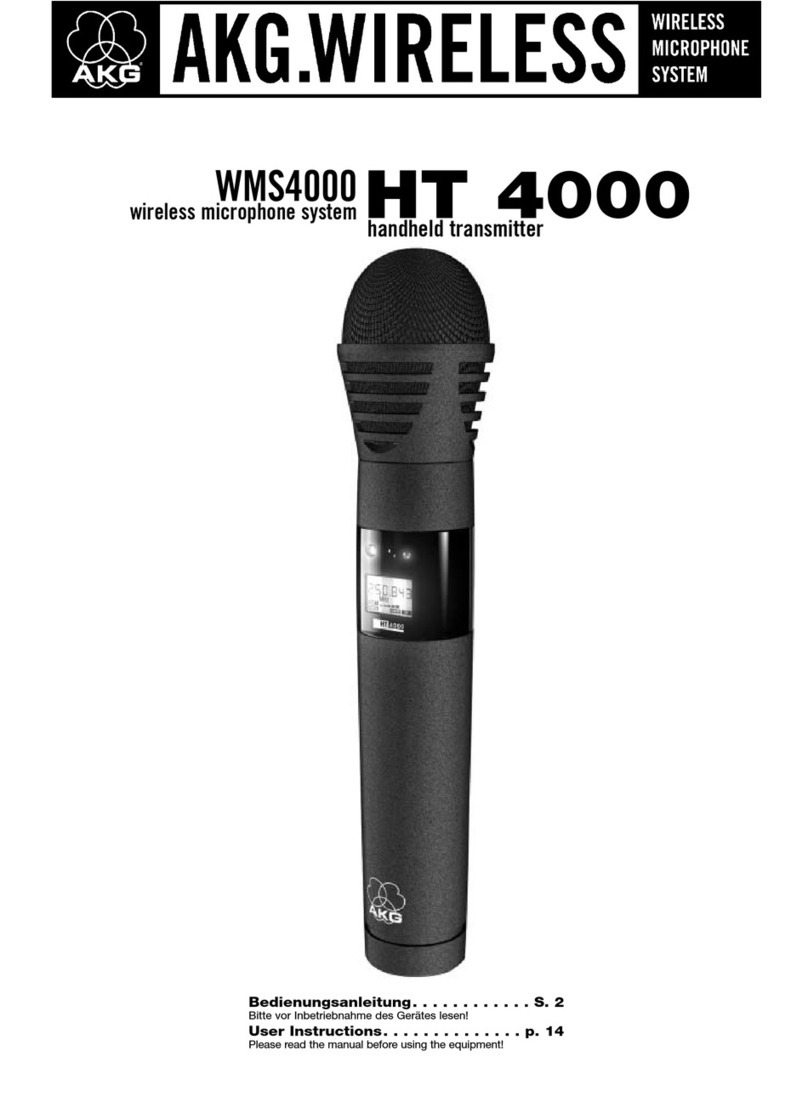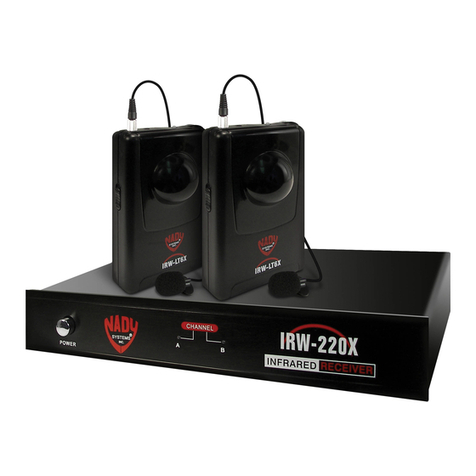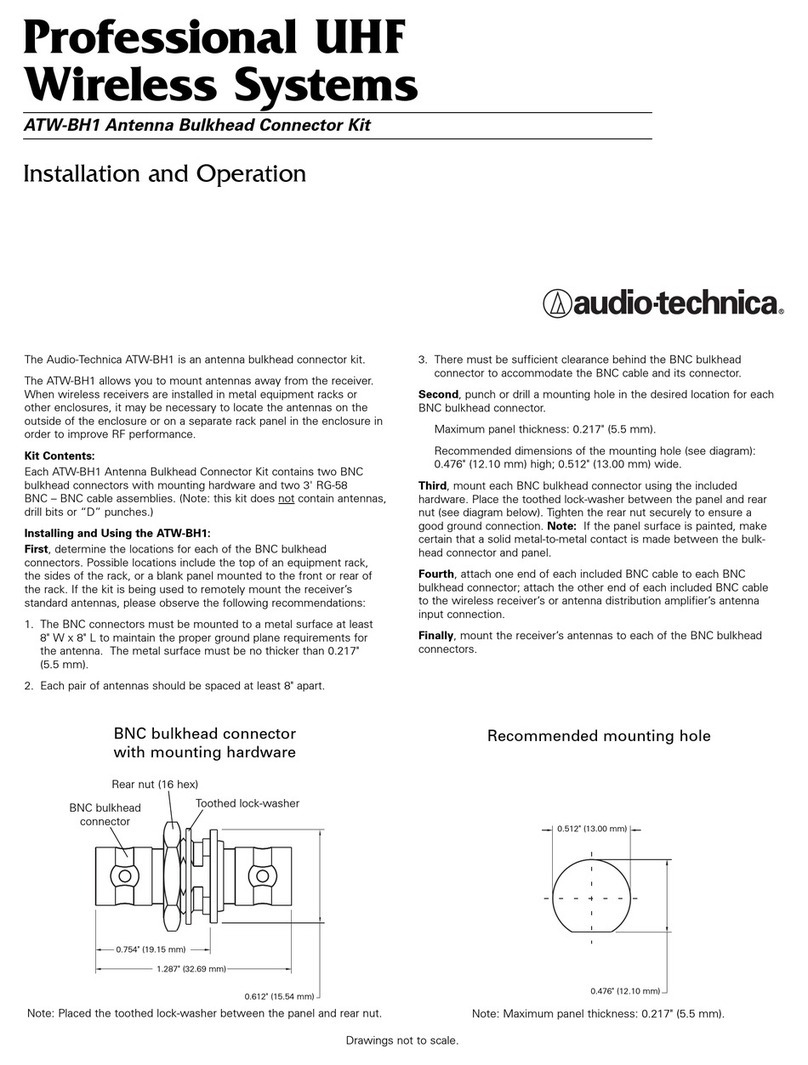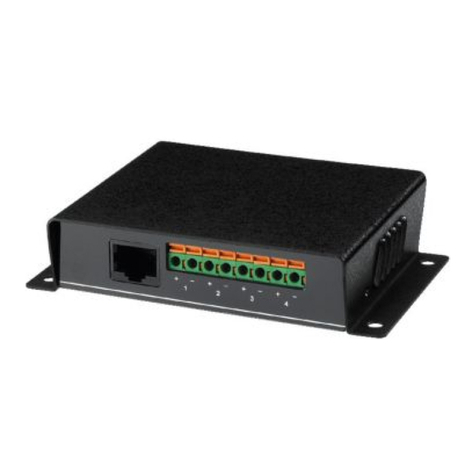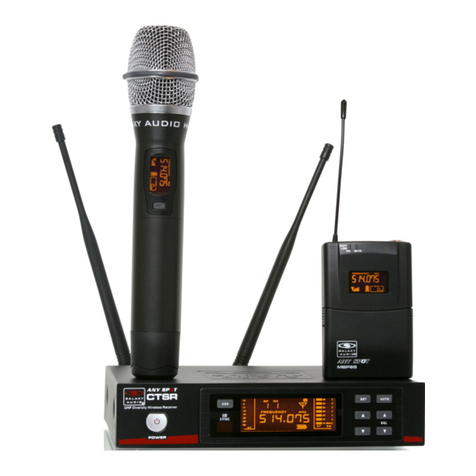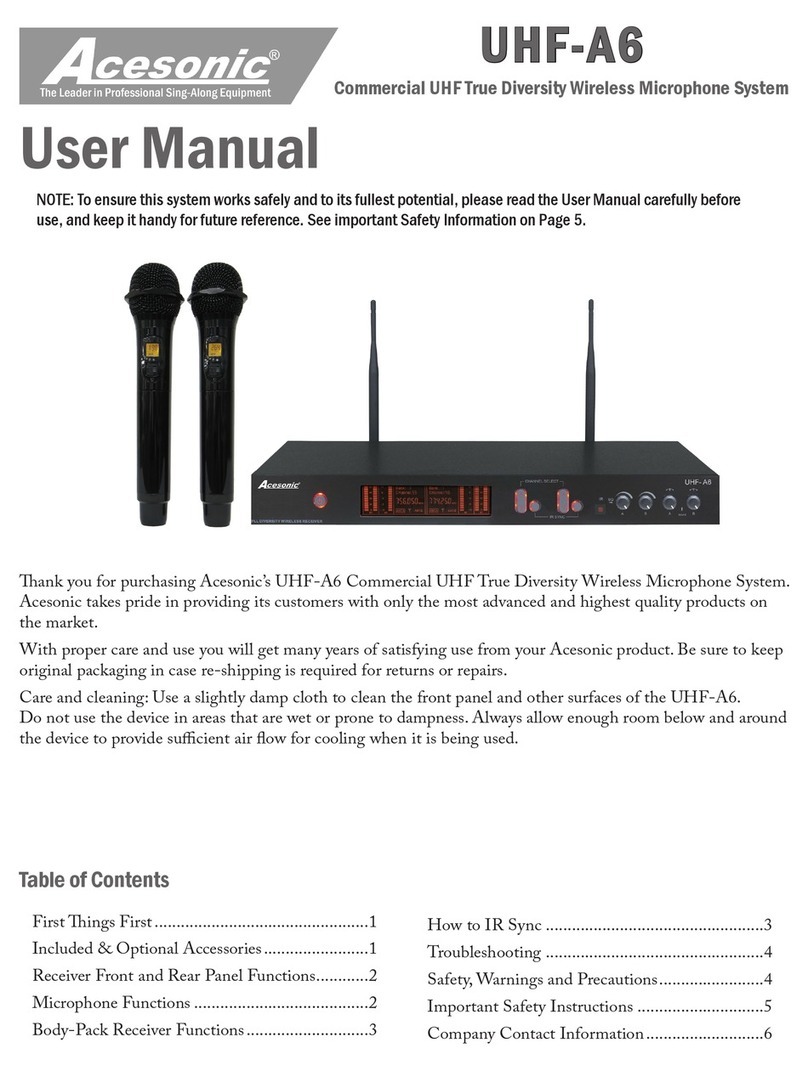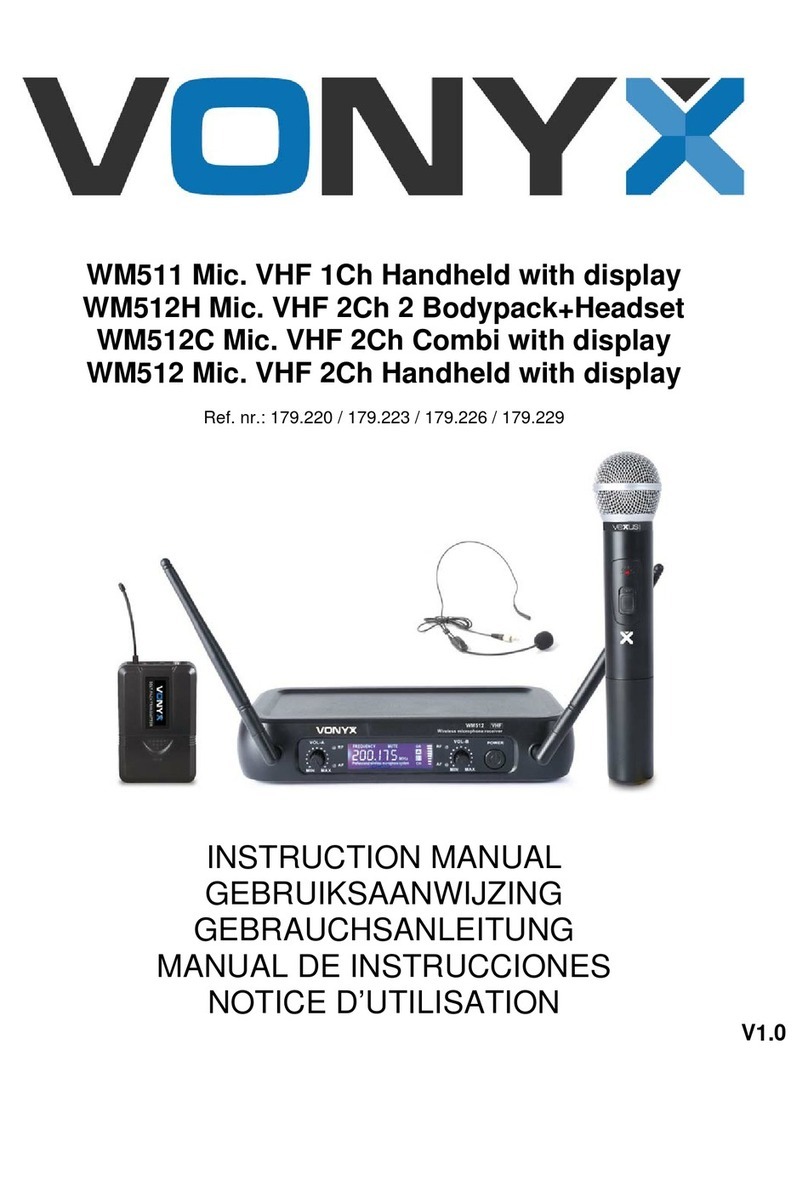FITNESS AUDIO DX6-DR User manual

Operation manual
DX6-DR / DX6-TF
Dual-Channel Three Redundancy Digital
Wireless Microphone System

1
DX6-DR / DX6-TF Dual-Channel Three Redundancy Digital Wireless Microphone System
Important safety instructions
◼READ, KEEP and HEED these instructions.
◼CLEAN ONLY with dry cloth.
◼DO NOT block any ventilation openings. Allow sufficient distances for adequate ventilation
and install in accordance with the manufacturer’s instructions.
◼DO NOT install or place near any heat sources such as open flames, radiators, heat registers,
stoves, or other apparatus (including amplifiers) that produce heat.
◼DO NOT defeat the safety purpose of the polarized or grounding type plug. A polarized plug
has two blades with one wider than the other. A grounding type plug has two blades and a
third grounding prong. The wider blade or the third prong are provided for your safety. If the
provided plug does not fit into your outlet, consult an electrician for replacement of the
obsolete outlet.
◼PROTECT the power cord from being walked on or pinched, particularly at plugs,
convenience receptacles, and the point where they exit from the apparatus.
◼ONLY USE attachments/accessories specified by the manufacturer.
◼USE only with a cart, stand, tripod, bracket, or table specified by the manufacturer, or sold
with the apparatus. When a cart is used, use caution when moving the cart/apparatus
combination to avoid injury from tip-over.
◼UNPLUG this apparatus during lightning storms or when unused for long periods of time.
◼REFER all servicing to qualified service personnel. Servicing is required when the apparatus
has been damaged in any way, such as power supply cord or plug is damaged, liquid has
been spilled or objects have fallen into the apparatus, the apparatus has been exposed to rain
or moisture, or does not operate normally.
◼To reduce the risk of fire or electric shock, do not expose this apparatus to rain or moisture.
◼Do not attempt to modify this product. Doing so could result in personal injury and/or product
failure.
Federal Communication Commission Interference Statement
This equipment has been tested and found to comply with the limits for a Class B digital device, pursuant to Part 15 of the
FCC Rules. These limits are designed to provide reasonable protection against harmful interference in a residential
installation.
This equipment generates, uses and can radiate radio frequency energy and, if not installed and used in accordance with
the instructions, may cause harmful interference to radio communications. However, there is no guarantee that interference
will not occur in a particular installation. If this equipment does cause harmful interference to radio or television reception,
which can be determined by turning the equipment off and on, the user is encouraged to try to correct the interference by
one of the following measures:
⚫Reorient or relocate the receiving antenna.
⚫Increase the separation between the equipment and receiver.
⚫Connect the equipment into an outlet on a circuit different from that to which the receiver is connected.
⚫Consult the dealer or an experienced radio/TV technician for help.
FCC Caution: To assure continued compliance, any changes or modifications not expressly approved by the party
responsible for compliance could void the user's authority to operate this equipment. (Example - use only shielded interface
cables when connecting to computer or peripheral devices).
FCC Radiation Exposure Statement
This equipment complies with FCC RF radiation exposure limits set forth for an uncontrolled environment. This equipment
should be installed and operated with a minimum distance of 0.5 centimeters between the radiator and your body.
This transmitter must not be co-located or operating in conjunction with any other antenna or transmitter.
The antennas used for this transmitter must be installed to provide a separation distance of at least 0.5 cm from all persons
and must not be co-located or operating in conjunction with any other antenna or transmitter.
This device complies with Part 15 of the FCC Rules. Operation is subject to the following two conditions:
(1).This device may not cause harmful interference, and
(2).This device must accept any interference received, including interference that may cause undesired operation
CE
◼Frequency: 2402~2480MHz, Maximal power: 20 mW (DX6-TF)
◼CE declaration info: www.chiayo.com.tw/declaration.html

2
Instructions
Thank you for choosing FITNESS AUDIO digital wireless microphone system!
For more details, please take a few moments to read this operating manual for thorough
understanding of the function and operation of both transmitter and receiver.
In the box
DX6-DR receiver
1 beltpack transmitter
a pair of antennas
audio cable
switching adaptor
(plug varies from country to country)
rackmount kit (MP-90S)
(Optional Extra. Refer to Fig.1 on P.4)
square fixing plate (1XA1027)
(Refer to Fig.2 on P.4)
operation manual
**The above specifications are subject to change without prior notice.
Important usage instructions
◼To cope with the complicated 2.4GHz wireless environment, the line-of-sight distance
between the microphone and the receiver should be shortened to ensure that the signal is not
blocked.
◼When one receiver is used with two microphones, it is recommended that the microphones be
set to A-SCAN mode. (Please refer to P13)
◼When two receivers are used with four microphones, the microphones should be set in F-
CH01~F-CH04 modes respectively and the modes cannot be repeated. (Please refer to P13)
◼The A-SCAN mode and F-CH01~F-CH04 mode cannot be mixed in the same system.
◼When the system encounters interference or signal interruption, try the following:
The microphone enters the A-SCAN function page and scans to search for the best
available channel.
The receiver should be kept at least 5 meters away from other WiFi, Bluetooth or 2.4GHz
devices in use.
Keep the distance between the microphone and the receiver at least 2 meters.
SYNC SETSYNC SET
CH
CH.
RF AF
MHz
02 6
2405
CH
CH.
RF AF
MHz
07 7
2456
S
D
R
-
590
0
UH
F雙頻
道數位鎖
定
自動
對
頻自動
選
訊無線麥克風
系
統

3
DX6-DR / DX6-TF Dual-Channel Three Redundancy Digital Wireless Microphone System
Parts and functions of DX6-DR receiver
Antenna A (SMA) LCD Antenna B (SMA)
SYNC SETSYNC SET
C H
CH.
RF A F
MHz
0 2 6
2405
C H
CH.
RF A F
MHz
0 7 7
2456
DC IN
12V
MIXED OUTMIC OUT 1
1.G
2.
3.
MIC OUT 2 LEVEL
MIC LINE
1.G
2.
3.
Power switch
MENU / SET button
UP button
DOWN button
Channel synchronization button
DC input
MIC/LINE output impedance switch
(only for mixed audio output)
Mixed audio output
CH 1 balanced audio output
CH 2 balanced audio output
CH 1
CH 2

4
Instructions
Antenna installation
Install supplied 2.4GHz receiver SMA antenna A and B at SMA connectors on the front panel.
Please make sure the antennas being firmly tightened otherwise the reception quality might be
affected.
Receiver placement
1. The receiver should be at least 1m above the ground and
1m away from a wall or metal surface to minimize
reflections.
2. The transmitter should also be at least 1m away from a
wall or metal surface to minimize reflections.
3. The transmitter should also be at least 1m away from the
receiver. Keep antennas away from noise source such as
motors, automobiles, neon light as well as large metal
objects.
4. The receiver should be at least 5m away from 2.4GHz wifi
or other 2.4GHz transmitting devices.
5. Power voltage should not below 12V DC or above 15V DC. Deficient current causes unstable
operating voltage or malfunction and over current shortens the product life and possibly
damages circuits.
Rack mounting
The receiver can be cabinet-mounted by either one or two units. If only one receiver is to be
mounted, an optional kit is available and it's installed as shown in Fig 1. If two receivers are to
be mounted, they can be assembled by another kit and installed as shown in Fig 2.
▌Rack mounting one receiver
Fig 1
▌Rack mounting two receivers
Fig 2
1m
1m
1m

5
DX6-DR / DX6-TF Dual-Channel Three Redundancy Digital Wireless Microphone System
Channel synchronization of the receiver and transmitter
1 Press and hold the transmitter’s synchronization button until “SYNC” flashes on the
LCD.
2 Press and hold the receiver’s SYNC button until the LCD displays “-Sync-”and the
channel number becomes the same as the transmitter indicative of successful channel
synchronization.
Volume adjustment
1 Press SET button to make the volume icon appear and flash.
2 Press DOWN(▼) and UP(▲) button to adjust the volume by 1dB / step, from -8dB
(min) to +8dB (max). The default volume is 0dB.
3 After a level is chosen, wait about 5 seconds to save the setting and the level will not
change after reboot until the setting is changed again.
SETSYNC
SETSYNC
SET
SYNC

6
Instructions
Setting microphone’s sensitivity from the receiver
1 Press SET button to make the sensitivity level flashes
→
2 Press DOWN(▼) and UP(▲) button to adjust the sensitivity level between -1, 0 and 1.
3 After a level is chosen, wait about 5 seconds to save the setting and the level will not
change after reboot until the setting is changed again.
1. Setting the sensitivity of the LAVALIER and HEADSET MICROPHONE of the beltpack
transmitter
Sensitivity value
-1
0
1
Dynamic range
high
middle
low
Noise & feedback
low
middle
high
Mic cartridge to mouth
< 10 cm
10 cm to 20 cm
> 20 cm
2. Setting the sensitivity of INSTRUMENT input of the beltpack transmitter
Sensitivity value
-1
0
1
When to choose
Instrument input
level too high
default
Instrument input
level too low
Function
Decrease input level
default
Increase input level
Important:
◼The farther distance from mouth the higher sensitivity is required. The default gain level is 0.
◼Higher sensitivity will lower the dynamic range of input signals, which may result in more
feedback concern.
◼Above description is for reference only. Please set the sensitivity at a proper level when
operating the microphone system.
SETSYNC
SET
SYNC

7
DX6-DR / DX6-TF Dual-Channel Three Redundancy Digital Wireless Microphone System
Notch filter
When noise signals are picked up by the microphone, notch filter can prevent these signals
entering the receiver. Its default status is ON.
◼If using belt-pack transmitter, it’s advised to turn on the notch filter.
◼If using handheld transmitter, it’s advised to turn off the notch filter.
1 Press SET button to make the text NF appear with ON / OFF flashing.
→
2 Press DOWN(▼) and UP(▲) button to turn ON / OFF the notch filter.
3 After a status is chosen, wait about 5 seconds to save the setting and the status will not
change after reboot until the setting is changed again.
SETSYNC
SET
SYNC

8
Instructions
Equalizer setting
Equalizer adjustment is actually used to increase or reduce the high/mid/low frequency
component of the speaker's restored sound. It is so-called raising or attenuating treble/bass via
frequency-specific volume controls to improve human voices or make musical instruments’
sound more prominent. According to the scale values on the screen, UP button is to increase
and boost and DOWN button to decrease and attenuate.
Adjust the level of high frequency (Treble), mid frequency (Mid), and low frequency (Bass)
respectively. All signals have been balanced by the high and low sounds after entering the
receiver so it is not necessary to adjust the equalizer during the output to the speaker. It is
recommended to maintain the value of BASS, MID and TREBLE at 0 dB.
DISPLAY
BASS
MID
TREBLE
FUNCTION
increase or decrease the low
frequencies
increase or decrease the mid
frequencies
increase or decrease the
high frequencies
RANGE
-8 dB~+8 dB
DEFAULT
0 dB
1 Press SET button to make the frequency icon appear with EQ value flashing.
Then press SET to choose your target EQ band between 300 (BASS), 1000 (MID) and
3000 (TREBLE) (Hz).
→→
BASS MID TREBLE
2 Press DOWN(▼) and UP(▲) button to adjust the EQ value by 2dB / step, from -8
(min) to 8 (max). The default BASS/MID/TREBLE level is 0 (dB).
3 After a level is chosen, wait about 5 seconds to save the setting and the level will not
change after reboot until the setting is changed again.
SETSYNC
SET
SYNC

9
DX6-DR / DX6-TF Dual-Channel Three Redundancy Digital Wireless Microphone System
Audio output connection
INDIVIDUAL balanced output
MIXED unbalanced output
XLR connector provides
balanced audio output signal
from this jack to the
mixer/amplifier. Use an audio
output cable with “XLR” or
“Cannon” connector, connect
one end to the balanced
output jack of the receiver,
and the other end to the “MIC
IN” jack of the mixer/
amplifier. (Fig 3)
¼” PHONE PLUG connector provides unbalanced audio
output signal from this jack to the mixer/amplifier. Use an
audio output cable with ¼” PHONE PLUG connectors.
Connect one end from the unbalanced output jack of the
receiver, and the other end to the “LINE IN” or “MIC IN”jack
of the mixer/ amplifier.
Level switch setting
◼When connecting to the LINE /AUX IN of a mixer/amplifier,
switch to “LINE” position (Fig 4). DO NOT use the “MIC”
position as they may not deliver a sufficient high output
level.
◼When connecting to the “MIC IN” jack of a mixer/amplifier,
switch to “MIC” position (Fig 5). Overload distortion may
occur at the wrong level position.
INDIVIDUAL output to MIC IN
MIXED output to LINE/AUX IN
MIXED output to MIC IN
Fig 3
Slide LEVEL switch to LINE
LINE/AUX IN
Fig 4
Slide LEVEL switch to MIC
MIC IN
Fig 5
DC I N
12 V
MI XED O UTMI C OU T 1
1.G
2.
3.
MI C OU T 2 LE VE L
MIC LINE
LEVEL
MIC LINE
DC I N
12V
MI XED O UTMI C OU T 1
1.G
2.
3.
MI C OU T 2 LEVE L
MIC LINE
LEVEL
MIC LINE
DC I N
12V
MI XED O UTMI C OU T 1
1.G
2.
3.
MI C OU T 2 LEVE L
MIC LINE
Mixer
▼
Amplifier
▼
Amplifier
▼

10
Instructions
Parts and functions of DX6-TF transmitter
Battery installation & indicator
1 This transmitter requires two AA batteries to operate. To install, remove the battery cover
and insert the batteries into the compartment.
2 Press the power button to turn on the transmitter. Press and hold the button for 2 seconds
to turn off.
3 The battery status can be monitored by the transmitter’s LCD
IMPORTANT: Batteries contain corrosive acid that may leak and damage the transmitter when stored for a
long period. Batteries should be removed from the transmitter before storing without use for more than 4
weeks.
Menu button
Setting button
Battery compartment
Channel synchronization button
Power button
Charging contacts
Audio input connector
for FITNESS AUDIO
headset / lavalier /
earworn microphone.
Cover release
button
LCD

11
DX6-DR / DX6-TF Dual-Channel Three Redundancy Digital Wireless Microphone System
Channel synchronization of the receiver and transmitter
1 Open the cover and hold the synchronization button until “SYNC”on the LCD flashes.
2 Hold the receiver’s SYNC button until the LCD displays “-Sync-”and the channel number
becomes the same as the transmitter indicative of successful channel synchronization.
Audio mute setting
1 Press the power button to enable MUTE mode and the signal of microphone will not enter
the transmitter. Press again to disable MUTE.
2 Under MUTE mode, the transmitter automatically turns off after 5 minutes.
SYNC

12
Instructions
Battery type setting
1 Use MENU button to go to the BATTERY TYPE page.
2 Press and hold SET button until NiMH or AKLN flashes to denote readiness for setting.
3 Press SET button to select either NiMH (rechargeable battery) or AKLN (alkaline battery).
4 6 seconds after selecting a battery type, it will be automatically saved and the type will not
change after reboot until the setting is changed again.
Important:
◼To avoid dangers from overcharging, please turn off the transmitter before charging
◼Do not charge primary batteries such as zink-carbon and alkaline batteries to avoid risks of
leakage or dangers.
◼Be sure to install the batteries by correct polarity to prevent device damages due to short
circuit.
◼Batteries of the same brand offer better quality consistency. Do not use batteries of different
brands as possible.
◼Do not mix new, old and different-brand batteries to prevent short circuit or malfunction.
◼If the transmitter will not be used for a long period of time, the batteries should be removed
and kept dry to avoid leakage and damage to the device due to battery self-discharge.
◼If the battery leaks, cracks or deforms, stop using and take it out immediately.

13
DX6-DR / DX6-TF Dual-Channel Three Redundancy Digital Wireless Microphone System
SCAN mode setting
There are five scan modes for selection: A-SCAN, F-CH01, F-CH02, F-CH03 and F-CH04.
Mode
A-SCAN
F-CH01
F-CH02
F-CH03
F-CH04
Function
The microphone will automatically
operate radio scanning to find and
locate a group of clear, interference-
free channels after entering A-SCAN
page and holding SET button.
There are four modes for selection.
Each mode includes several working
channels which are different from
those in any other mode.
When to choose
◼First-time operation.
◼Obvious environmental
interference exists / happens.
◼Only one DX6-DR system (two
transmitters) in the room.
◼Two DX6-DR systems (four
transmitters) to operate
simutaneously in the same room.
◼One system operates on F-CH01
and F-CH02 modes and the other
system on F-CH03 and F-CH04.
Auto freq hopping
Yes
Yes
1 Use MENU button to go to the SCAN mode page.
2 Press and hold SET button until the scan mode flashes to denote readiness for setting.
3 Press SET or MENU button to select a scan mode between A-SCAN, F-CH01, F-CH02, F-
CH03 and F-CH04. 6 seconds after selecting a scan mode, it will be automatically saved
and the mode will not change after reboot until the setting is changed again.
4 Without any button pressed, the transmitter will operate scanning and then change to A-
SCAN mode.

14
Instructions
POWER LINK ANT.
MUSICRECEIVER 5

This manual suits for next models
1
Table of contents
Other FITNESS AUDIO Microphone System manuals

FITNESS AUDIO
FITNESS AUDIO U Series Wireless Mic System User manual
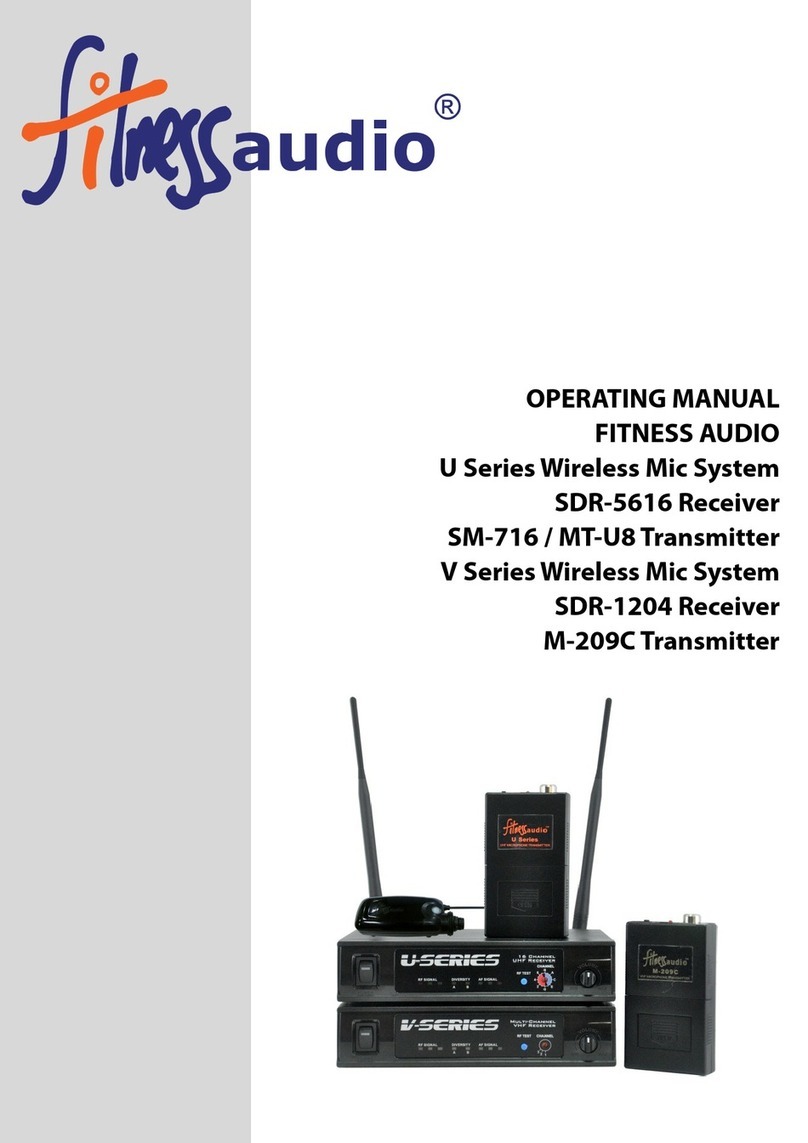
FITNESS AUDIO
FITNESS AUDIO V Series User manual
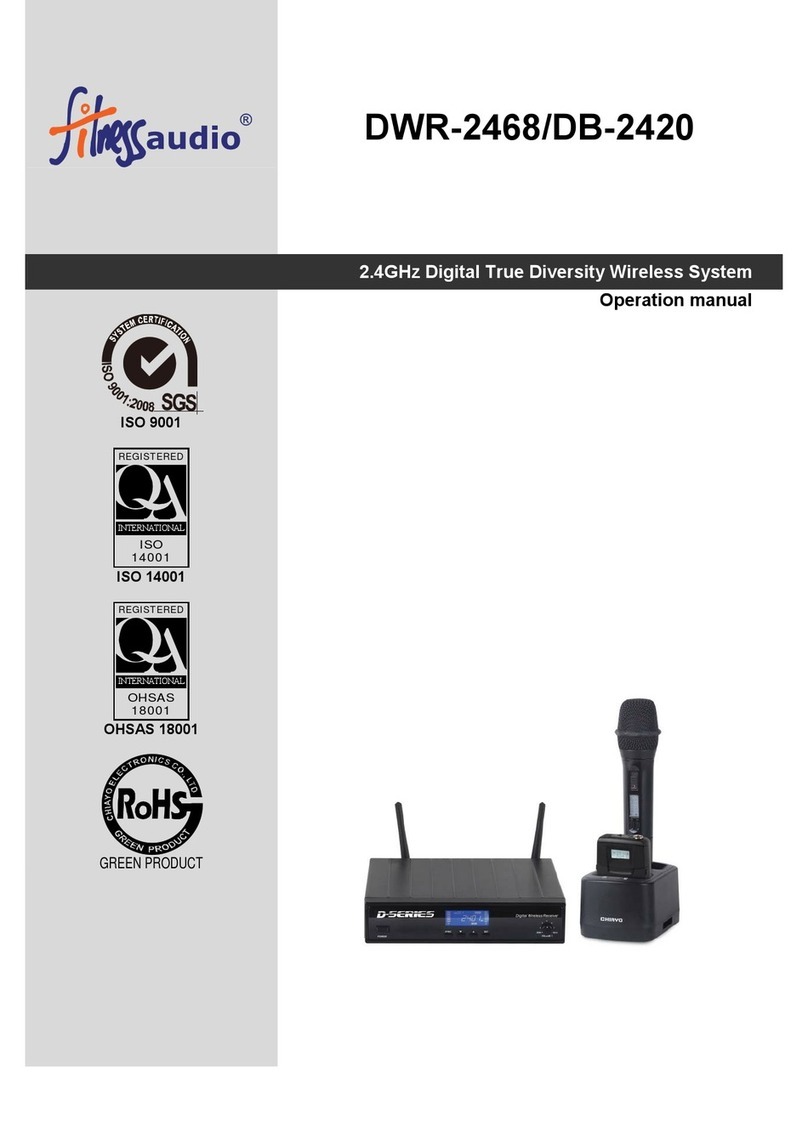
FITNESS AUDIO
FITNESS AUDIO DWR-2468 User manual

FITNESS AUDIO
FITNESS AUDIO SDR-5716 User manual

FITNESS AUDIO
FITNESS AUDIO U Series User manual

FITNESS AUDIO
FITNESS AUDIO SDR-1716 User manual

FITNESS AUDIO
FITNESS AUDIO SDR-5616 User manual
